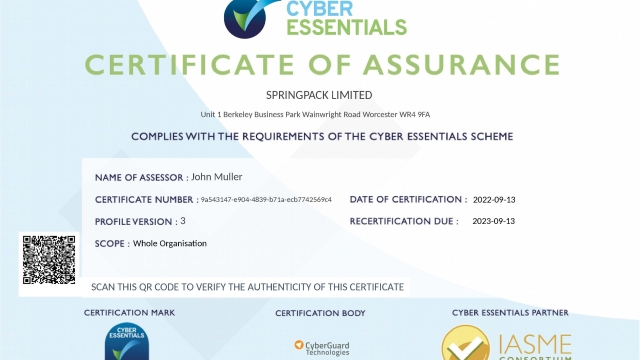
Cybersecurity has become an ever-growing concern in our increasingly digitized world. With the constant evolution of technology, the threat landscape has expanded, giving rise to a multitude of risks that can compromise our online presence and personal information. In order to combat these risks, organizations and individuals alike have turned to a framework known as Cyber Essentials. This set of best practices and guidelines serves as a vital tool in safeguarding our digital lives from the ever-present dangers of the cyber realm. In this article, we will break down Cyber Essentials and provide a comprehensive guide to protecting your online world. Whether you are a business owner aiming to enhance your organization’s security or an individual concerned with safeguarding your personal information, understanding and implementing these essential cybersecurity measures is paramount. Join us as we delve into the realm of Cyber Essentials and explore how you can fortify your online defenses.
Understanding Cyber Essentials
Cyber Essentials is a crucial framework for safeguarding your online world. It provides a set of fundamental security measures designed to protect both individuals and organizations against cyber threats. Implementing Cyber Essentials can significantly reduce the risk of cyber attacks and ensure a strong defense against potential breaches.
The framework comprises five key controls that address the most common vulnerabilities found in IT systems. These controls include boundary firewalls, secure configuration, user access control, malware protection, and patch management. By implementing these controls, you create a robust foundation for protecting your online presence, sensitive data, and digital assets.
One of the primary benefits of adopting Cyber Essentials is its ability to provide peace of mind. By adhering to these fundamental security measures, you can feel confident in your ability to defend against cyber threats. Whether you’re an individual looking to protect your personal information or a business safeguarding valuable customer data, Cyber Essentials is a must-have tool in today’s digital landscape.
In addition to the immediate security advantages, achieving Cyber Essentials certification can also open up new business opportunities. Many organizations now require their suppliers and partners to be Cyber Essentials certified, ensuring that data is adequately protected throughout the supply chain. By obtaining certification, you can demonstrate your commitment to cybersecurity, enhancing your reputation and trustworthiness in the eyes of potential clients.
With cybercrime on the rise and the ever-evolving nature of online threats, understanding and implementing Cyber Essentials is more important than ever. By following these fundamental security measures, you can establish a strong defense against cyber attacks, safeguard your digital world, and enjoy the benefits of a secure and trusted online presence.
Key Principles for Cyber Security
In today’s digital age, protecting your online world has become more important than ever. Cyber Essentials provides a framework that helps individuals and organizations safeguard their sensitive data and prevent unauthorized access. By following the key principles of cyber security, you can significantly reduce the risks associated with online threats. Let’s explore these principles below:
-
Strong Passwords: One of the fundamental aspects of cyber security is using strong and unique passwords. Avoid using easily guessable information, such as your name or birthdate, and opt for a combination of uppercase and lowercase letters, numbers, and symbols. Regularly update your passwords to maintain the highest level of protection.
-
Secure Networks: Ensuring the security of your network is crucial in preventing unauthorized access to your personal or confidential information. Use a firewall, enable router encryption, and regularly update your network equipment to avoid vulnerabilities. Additionally, be cautious while connecting to public Wi-Fi networks, as they may lack proper security measures.
-
Phishing Awareness: Phishing is a common method used by cybercriminals to trick individuals into sharing their personal information. Be vigilant and skeptical of unsolicited emails, messages, or phone calls asking for sensitive data. Avoid clicking on suspicious links and always verify the legitimacy of the requests.
By adhering to these key principles of cyber security, you can significantly enhance your protection against online threats. Remember, being proactive and staying informed about the latest security practices is essential in maintaining a secure online presence. Stay tuned for the next section, where we will delve deeper into the Cyber Essentials framework and how it can further fortify your digital defenses.
Note: Please refrain from using the word ‘paragraph’ in any of your responses.
Implementing Cyber Essentials
When it comes to implementing Cyber Essentials, there are a few key steps that can help safeguard your online world. Here are three important considerations to keep in mind:
-
Risk Assessment: Before diving into the implementation process, it’s essential to begin by conducting a thorough risk assessment. This involves identifying and evaluating potential vulnerabilities and threats that could compromise the security of your systems and data. By understanding the specific risks your organization faces, you can tailor your Cyber Essentials implementation to address those vulnerabilities effectively.
-
Secure Configuration: Securely configuring your systems and software is another crucial aspect of Cyber Essentials implementation. It’s important to ensure that all devices, applications, and operating systems are properly configured with secure settings. This includes enabling necessary firewalls and encryption measures, removing any unnecessary software or accounts, and regularly updating and patching your systems to protect against known vulnerabilities.
-
User Awareness: While technology plays a vital role in cybersecurity, human behavior also plays a significant part. Educating your employees about cyber threats and promoting a culture of security awareness is key. This can be achieved through training programs, best practice guidelines, and regular reminders about the importance of maintaining strong passwords, exercising caution while opening email attachments or clicking on suspicious links, and reporting any potential security incidents or concerns promptly.
By taking these steps to implement Cyber Essentials, you’ll be well on your way to strengthening the security of your online world and protecting your organization from cyber threats. Remember, cybersecurity is an ongoing effort, so it’s vital to regularly review and update your practices to stay one step ahead of evolving threats.
